Identifying the Early Post-Mortem VOC Profile from Cadavers in a Morgue Environment Using Comprehensive Two-Dimensional Gas Chromatography
Abstract
:1. Introduction
2. Materials and Methods
2.1. Experimental Design
2.2. VOC Sample Collection
2.3. Standards
2.4. VOC Analysis
2.5. Data Processing
2.5.1. Data Processing in ChromaTOF (v.5.51; LECO)
2.5.2. Data Processing in R
Peak Table Alignment
Data Filtering and Sample/Control Couple Comparison
3. Results
3.1. Overall VOC and Chemical Class Abundance Detected in the Morgue
3.2. Principal Component Analysis (PCA)
4. Discussion
4.1. Overall VOC and Chemical Class Abundance Detected in the Morgue Donor Samples
4.2. Principal Component Analysis
4.3. Limitations
5. Conclusions
Supplementary Materials
Author Contributions
Funding
Institutional Review Board Statement
Data Availability Statement
Conflicts of Interest
References
- Stuart, B. Decomposition chemistry: Overview, analysis, and interpretation. In Encyclopedia of Forensic Sciences; Elsevier: Amsterdam, The Netherlands, 2013; Volume 2, pp. 11–15. [Google Scholar]
- Forbes, S.L.; Perrault, K.A.; Comstock, J.L. Microscopic post-mortem changes: The chemistry of decomposition. In Taphonomy of Human Remains: Forensic Analysis of the Dead and the Depositional Environment; Wiley Online Library: Hoboken, NJ, USA, 2017; pp. 26–38. [Google Scholar]
- Knight, B. Forensic Pathology; Oxford University Press: Oxford, UK, 1991. [Google Scholar]
- Dent, B.B.; Forbes, S.L.; Stuart, B.H. Review of human decomposition processes in soil. Environ. Geol. 2004, 45, 576–585. [Google Scholar] [CrossRef]
- Clark, M.A.; Worrell, M.B.; Pless, J.E. Postmortem changes in soft tissues. Forensic Taphon. Postmortem Fate Hum. Remain. 1997, 151–164. [Google Scholar]
- Vass, A.A.; Barshick, S.-A.; Sega, G.; Caton, J.; Skeen, J.T.; Love, J.C.; Synstelien, J.A. Decomposition chemistry of human remains: A new methodology for determining the postmortem interval. J. Forensic Sci. 2002, 47, 542–553. [Google Scholar] [CrossRef] [PubMed]
- Forbes, S.L.; Perrault, K.A.; Stefanuto, P.-H.; Nizio, K.D.; Focant, J.-F. Comparison of the decomposition VOC profile during winter and summer in a moist, mid-latitude (Cfb) climate. PLoS ONE 2014, 9, e113681. [Google Scholar] [CrossRef] [PubMed]
- Stefanuto, P.-H.; Perrault, K.A.; Stadler, S.; Pesesse, R.; LeBlanc, H.N.; Forbes, S.L.; Focant, J.-F. GC × GC–TOFMS and supervised multivariate approaches to study human cadaveric decomposition olfactive signatures. Anal. Bioanal. Chem. 2015, 407, 4767–4778. [Google Scholar] [CrossRef]
- Knobel, Z.; Ueland, M.; Nizio, K.D.; Patel, D.; Forbes, S.L. A comparison of human and pig decomposition rates and odour profiles in an Australian environment. Aust. J. Forensic Sci. 2019, 51, 557–572. [Google Scholar] [CrossRef]
- Mochalski, P.; Unterkofler, K.; Teschl, G.; Amann, A. Potential of volatile organic compounds as markers of entrapped humans for use in urban search-and-rescue operations. TrAC Trends Anal. Chem. 2015, 68, 88–106. [Google Scholar] [CrossRef]
- Agapiou, A.; Amann, A.; Mochalski, P.; Statheropoulos, M.; Thomas, C.L.P. Trace detection of endogenous human volatile organic compounds for search, rescue and emergency applications. TrAC Trends Anal. Chem. 2015, 66, 158–175. [Google Scholar] [CrossRef]
- Armstrong, P.; Nizio, K.D.; Perrault, K.A.; Forbes, S.L. Establishing the volatile profile of pig carcasses as analogues for human decomposition during the early postmortem period. Heliyon 2016, 2, e00070. [Google Scholar] [CrossRef]
- Tsokos, M. Forensic Pathology Reviews; Springer: Berlin/Heidelberg, Germany, 2007; Volume 4. [Google Scholar]
- DeGreeff, L.E.; Furton, K.G. Collection and identification of human remains volatiles by non-contact, dynamic airflow sampling and SPME-GC/MS using various sorbent materials. Anal. Bioanal. Chem. 2011, 401, 1295–1307. [Google Scholar] [CrossRef]
- Stadler, S.; Stefanuto, P.-H.; Brokl, M.; Forbes, S.L.; Focant, J.-F. Characterization of volatile organic compounds from human analogue decomposition using thermal desorption coupled to comprehensive two-dimensional gas chromatography–time-of-flight mass spectrometry. Anal. Chem. 2013, 85, 998–1005. [Google Scholar] [CrossRef]
- Deo, A.; Forbes, S.L.; Stuart, B.H.; Ueland, M. Profiling the seasonal variability of decomposition odour from human remains in a temperate Australian environment. Aust. J. Forensic Sci. 2020, 52, 654–664. [Google Scholar] [CrossRef]
- Ueland, M.; Harris, S.; Forbes, S.L. Detecting volatile organic compounds to locate human remains in a simulated collapsed building. Forensic Sci. Int. 2021, 323, 110781. [Google Scholar] [CrossRef] [PubMed]
- Perrault, K.A.; Nizio, K.D.; Forbes, S.L. A Comparison of One-Dimensional and Comprehensive Two-Dimensional Gas Chromatography for Decomposition Odour Profiling Using Inter-Year Replicate Field Trials. Chromatographia 2015, 78, 1057–1070. [Google Scholar] [CrossRef]
- Stefanuto, P.H.; Rosier, E.; Tytgat, J.; Focant, J.F.; Cuypers, E. Profiling volatile organic compounds of decomposition. In Taphonomy of Human Remains: Forensic Analysis of the Dead and the Depositional Environment:Forensic Analysis of the Dead and the Depositional Environment; Wiley Online Library: Hoboken, NJ, USA, 2017; pp. 39–52. [Google Scholar]
- Nizio, K.D.; Cochran, J.W.; Forbes, S.L. Achieving a Near-Theoretical Maximum in Peak Capacity Gain for the Forensic Analysis of Ignitable Liquids Using GC×GC-TOFMS. Separations 2016, 3, 26. [Google Scholar] [CrossRef]
- Ramos, L. Comprehensive Two Dimensional Gas Chromatography; Elsevier: Amsterdam, The Netherlands, 2009. [Google Scholar]
- Woolfenden, E.; McClenny, W. Compendium Method TO-17. In Determination of Volatile Organic Compounds in Ambient Air Using Active Sampling Onto Sorbent Tubes; US EPA: Cincinnati, OH, USA, 1999. [Google Scholar]
- Statheropoulos, M.; Spiliopoulou, C.; Agapiou, A. A study of volatile organic compounds evolved from the decaying human body. Forensic Sci. Int. 2005, 153, 147–155. [Google Scholar] [CrossRef] [PubMed]
- Statheropoulos, M.; Agapiou, A.; Pallis, G. A study of volatile organic compounds evolved in urban waste disposal bins. Atmos. Environ. 2005, 39, 4639–4645. [Google Scholar] [CrossRef]
- McKeage, K.; Perry, C.M. Propofol. CNS Drugs 2003, 17, 235–272. [Google Scholar] [CrossRef]
- Lo, T.S.; Hammer, K.D.P.; Zegarra, M.; Cho, W.C.S. Methenamine: A forgotten drug for preventing recurrent urinary tract infection in a multidrug resistance era. Expert Rev. Anti-Infect. Ther. 2014, 12, 549–554. [Google Scholar] [CrossRef]
- Zhou, C.; Byard, R.W. Factors and processes causing accelerated decomposition in human cadavers–an overview. J. Forensic Leg. Med. 2011, 18, 6–9. [Google Scholar] [CrossRef]
- Statheropoulos, M.; Agapiou, A.; Spiliopoulou, C.; Pallis, G.C.; Sianos, E. Environmental aspects of VOCs evolved in the early stages of human decomposition. Sci. Total Environ. 2007, 385, 221–227. [Google Scholar] [CrossRef]
- Boumba, V.A.; Ziavrou, K.S.; Vougiouklakis, T. Biochemical pathways generating post-mortem volatile compounds co-detected during forensic ethanol analyses. Forensic Sci. Int. 2008, 174, 133–151. [Google Scholar] [CrossRef]
- Paczkowski, S.; Schütz, S. Post-mortem volatiles of vertebrate tissue. Appl. Microbiol. Biotechnol. 2011, 91, 917–935. [Google Scholar] [CrossRef]
- Mochalski, P.; King, J.; Unterkofler, K.; Hinterhuber, H.; Amann, A. Emission rates of selected volatile organic compounds from skin of healthy volunteers. J. Chromatogr. B Analyt. Technol. Biomed. Life Sci. 2014, 959, 62–70. [Google Scholar] [CrossRef] [PubMed]
- Jiang, R.; Cudjoe, E.; Bojko, B.; Abaffy, T.; Pawliszyn, J. A non-invasive method for in vivo skin volatile compounds sampling. Anal. Chim. Acta 2013, 804, 111–119. [Google Scholar] [CrossRef] [PubMed]
- Rust, L.; Nizio, K.D.; Forbes, S.L. The influence of ageing and surface type on the odour profile of blood-detection dog training aids. Anal. Bioanal. Chem. 2016, 408, 6349–6360. [Google Scholar] [CrossRef]
- Gallagher, M.; Wysocki, C.J.; Leyden, J.J.; Spielman, A.I.; Sun, X.; Preti, G. Analyses of volatile organic compounds from human skin. Br. J. Dermatol. 2008, 159, 780–791. [Google Scholar] [CrossRef]
- Dormont, L.; Bessière, J.-M.; McKey, D.; Cohuet, A. New methods for field collection of human skin volatiles and perspectives for their application in the chemical ecology of human–pathogen–vector interactions. J. Exp. Biol. 2013, 216, 2783–2788. [Google Scholar] [CrossRef]
- Penn, D.J.; Oberzaucher, E.; Grammer, K.; Fischer, G.; Soini, H.A.; Wiesler, D.; Novotny, M.V.; Dixon, S.J.; Xu, Y.; Brereton, R.G. Individual and gender fingerprints in human body odour. J. R. Soc. Interface 2007, 4, 331–340. [Google Scholar] [CrossRef] [PubMed]
- Curran, A.M.; Rabin, S.I.; Prada, P.A.; Furton, K.G. Comparison of the volatile organic compounds present in human odour using SPME-GC/MS. J. Chem. Ecol. 2005, 31, 1607–1619. [Google Scholar] [CrossRef] [PubMed]
- Shirasu, M.; Touhara, K. The scent of disease: Volatile organic compounds of the human body related to disease and disorder. J. Biochem. 2011, 150, 257–266. [Google Scholar] [CrossRef]
- Rosier, E.; Loix, S.; Develter, W.; Van de Voorde, W.; Tytgat, J.; Cuypers, E. The search for a volatile human specific marker in the decomposition process. PLoS ONE 2015, 10, e0137341. [Google Scholar] [CrossRef] [PubMed]
- Vass, A.A.; Smith, R.R.; Thompson, C.V.; Burnett, M.N.; Wolf, D.A.; Synstelien, J.A.; Dulgerian, N.; Eckenrode, B.A. Decompositional odor analysis database. J. Forensic Sci. 2004, 49, 760–769. [Google Scholar] [CrossRef]
- Vass, A.A. Odor mortis. Forensic Sci. Int. 2012, 222, 234–241. [Google Scholar] [CrossRef] [PubMed]
- Hoffman, E.M.; Curran, A.M.; Dulgerian, N.; Stockham, R.A.; Eckenrode, B.A. Characterization of the volatile organic compounds present in the headspace of decomposing human remains. Forensic Sci. Int. 2009, 186, 6–13. [Google Scholar] [CrossRef] [PubMed]
- Trumbo, S.T.; Steiger, S. Finding a fresh carcass: Bacterially derived volatiles and burying beetle search success. Chemoecology 2020, 30, 287–296. [Google Scholar] [CrossRef]
- Martin, C.; Verheggen, F. Odour profile of human corpses: A review. Forensic Chem. 2018, 10, 27–36. [Google Scholar] [CrossRef]
- Dargan, R.; Samson, C.; Burr, W.S.; Daoust, B.; Forbes, S.L. Validating the Use of Amputated Limbs Used as Cadaver Detection Dog Training Aids. Front. Anal. Sci. 2022, 2, 934639. [Google Scholar] [CrossRef]
- Wescott, D.J. Recent Advances in Forensic Anthropology: Decomposition Research. Forensic Sci. Res. 2018, 3, 278–293. [Google Scholar] [CrossRef] [PubMed]
- Patel, D. Identifying the Transition from Ante-Mortem Odour to Post-Mortem Odour Traditional; Université du Québec à Trois-Rivières: Québec, QC, Canada, 2023. [Google Scholar]
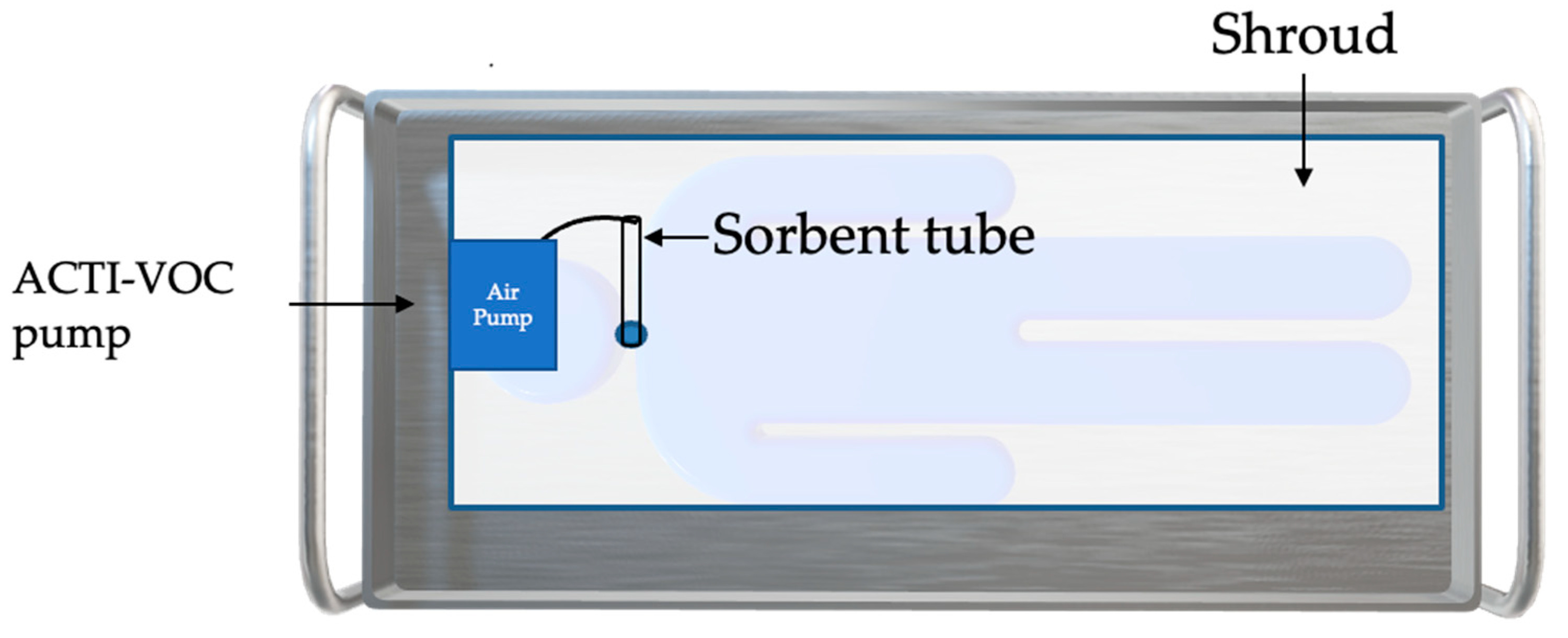
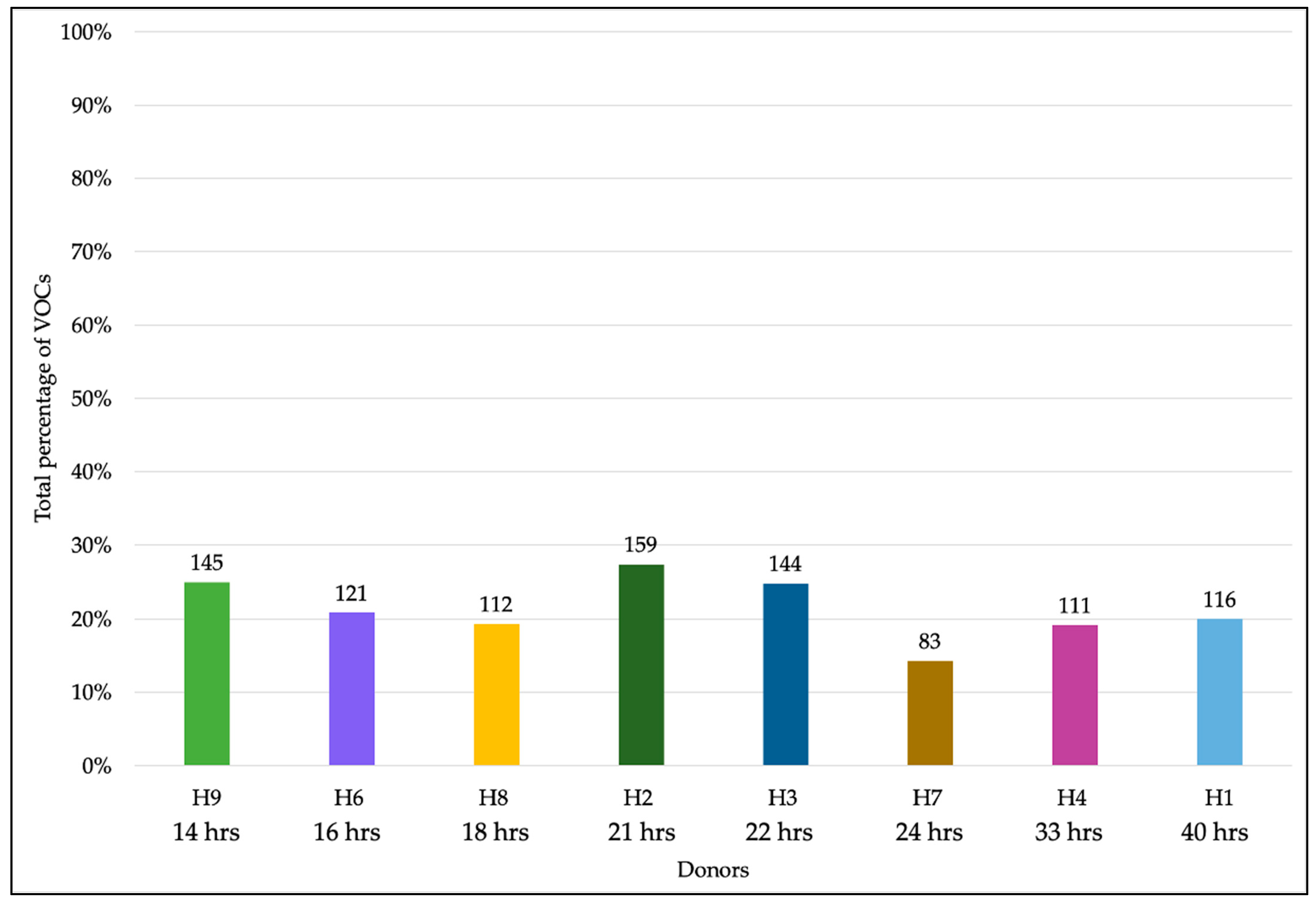
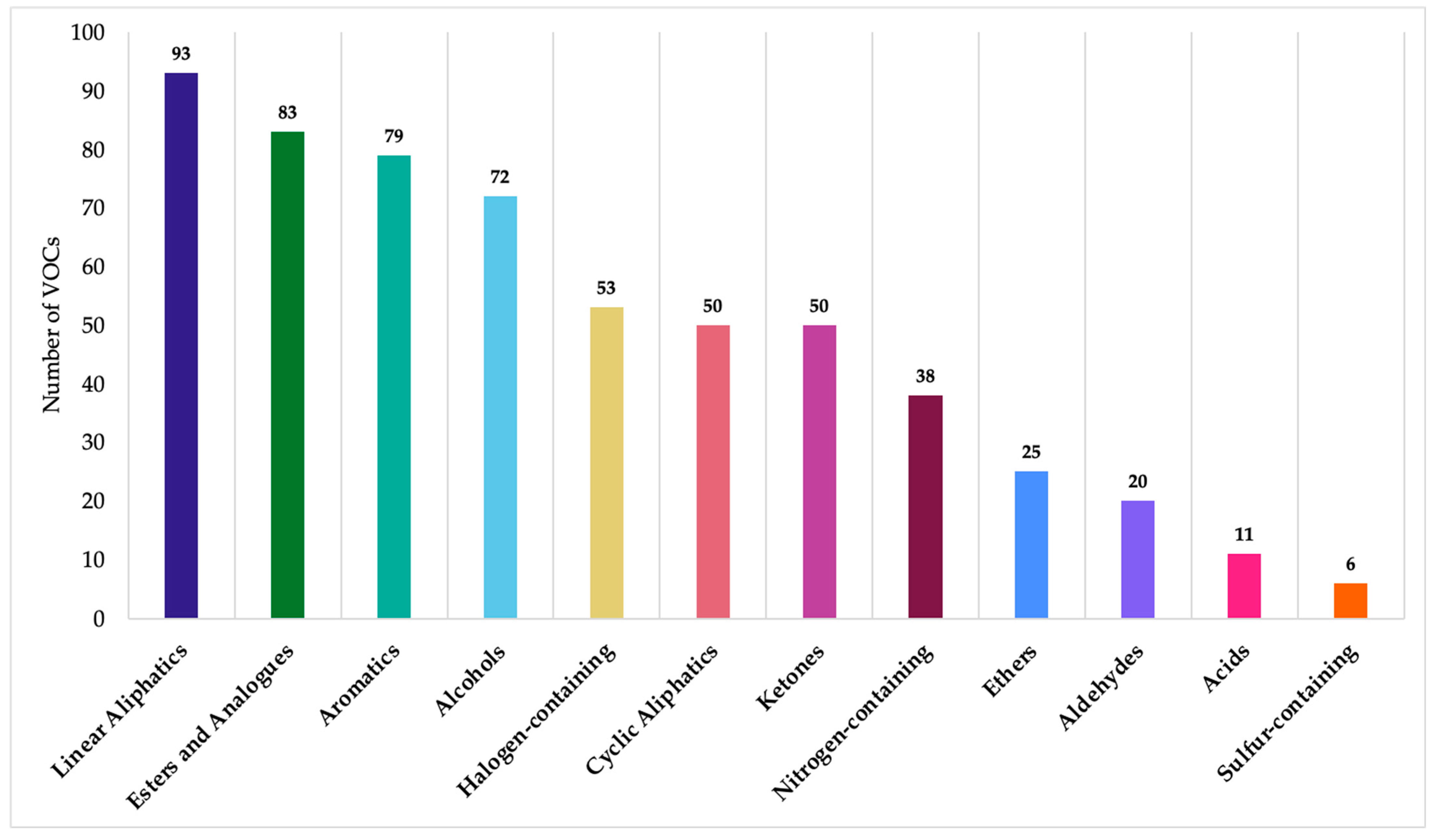
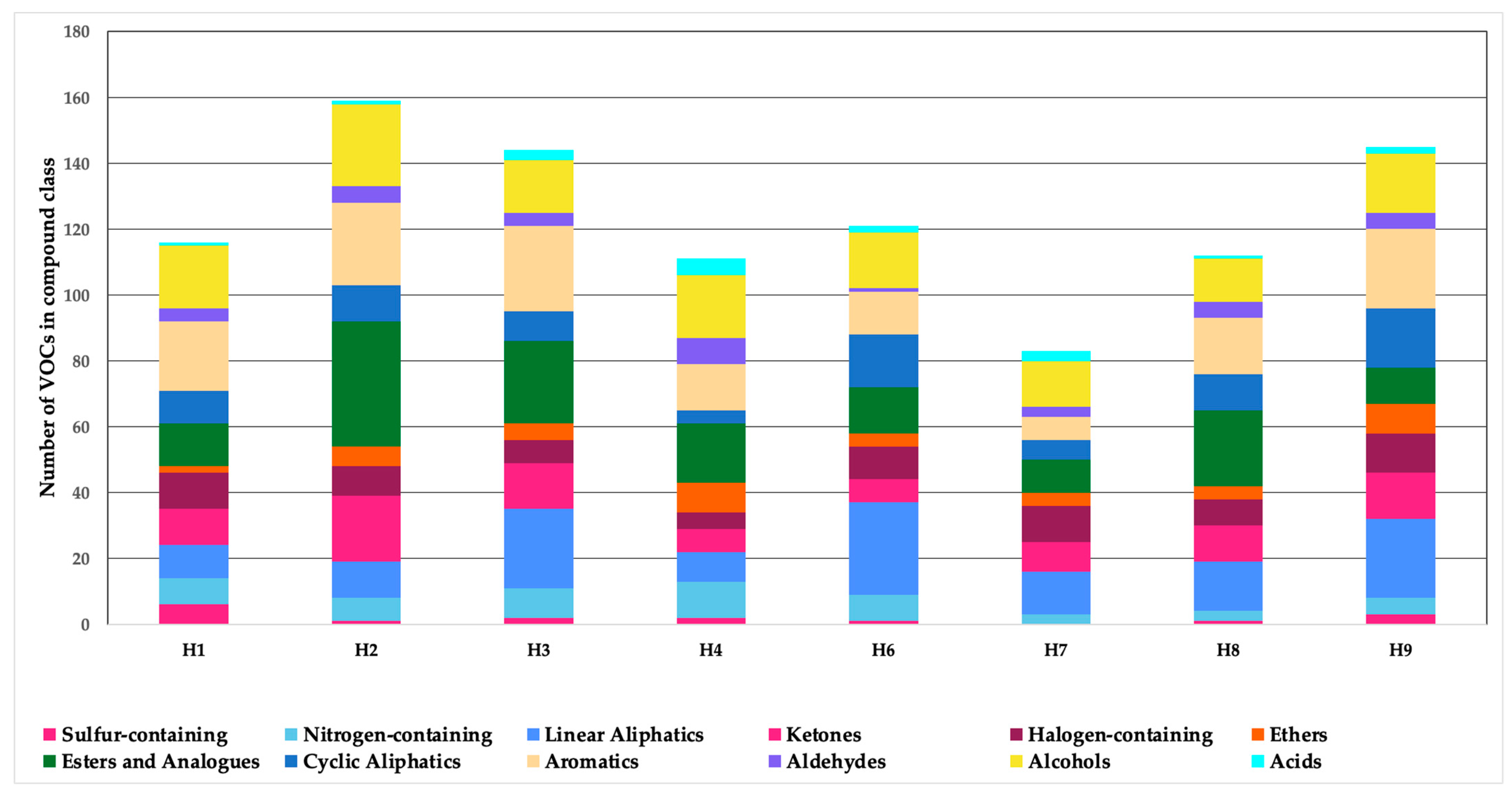


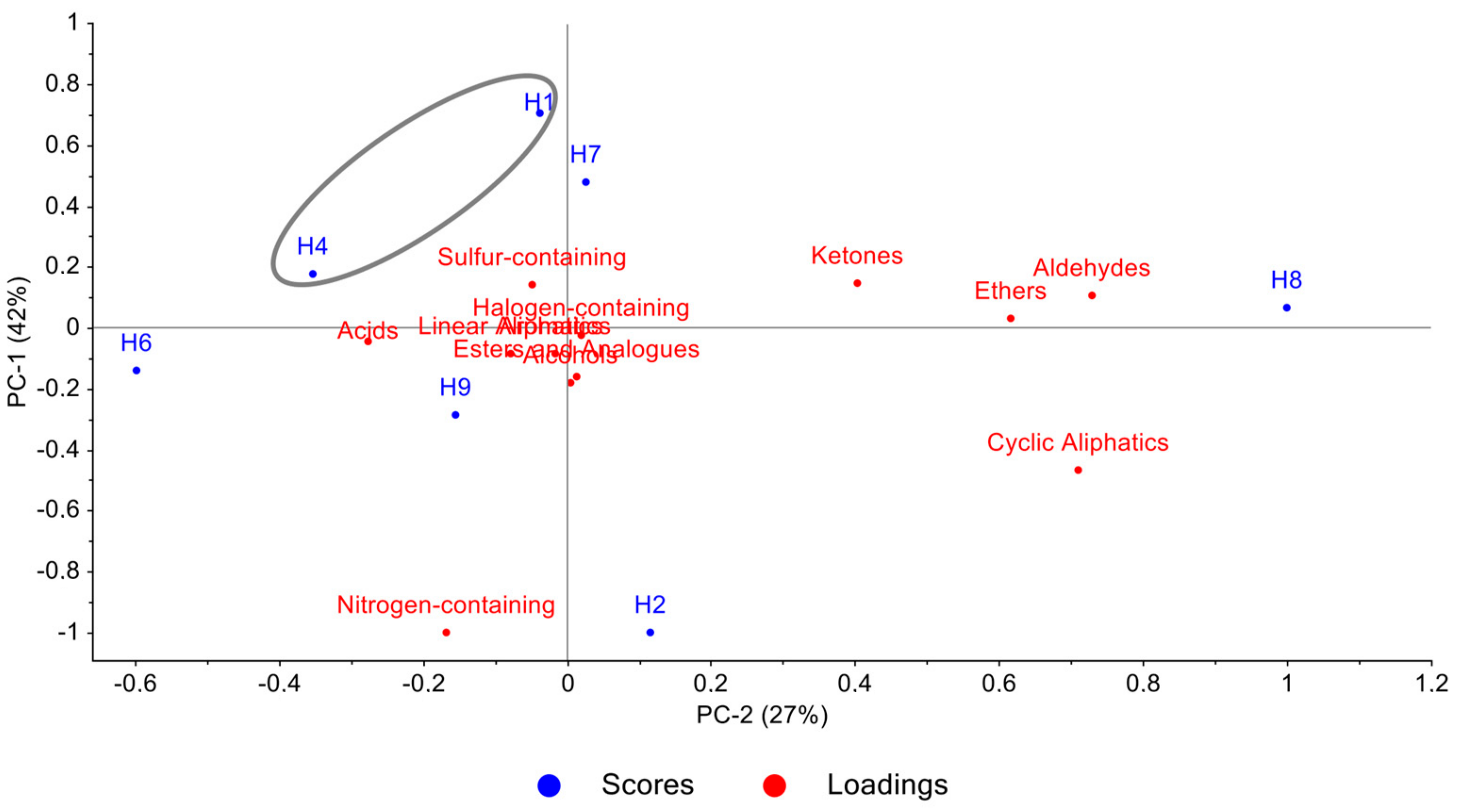
| Donors | VOCs | Chemical Class | Uses | References |
|---|---|---|---|---|
| H3 | Propofol | Alcohol | Inhalation and intravenous anesthetic | [25] |
| H4 | Methenamine | Nitrogen-containing compound | Antibacterial (urinary tract infection) | [26] |
| VOC | Frequency (Out of 8 Donors) | Percentage Abundance (%) | Potential Sources | Previously Reported in the Literature |
|---|---|---|---|---|
| 6-methylhept-5-en-2-one | 7 | 37.5 | Human scent study | [33] |
| Acetic acid, butyl ester | 5 | 62.5 | Skin | [34] |
| Benzyl alcohol | 3 | 37.5 | Skin | [35] |
| Decanoic acid, ethyl ester | 3 | 37.5 | Skin | [31] |
| Hexanoic acid, methyl ester | 4 | 50 | Skin | [36] |
| 1,3-Dioxolane, 2-methyl- | 3 | 37.5 | Skin | [14,37] |
| 2,3-Pentanedione | 5 | 62.5 | Skin (axillary skin)/sweat | [38] |
| 1-Octen-3-one | 4 | 50 | Urine | [14] |
| VOC | Frequency (Out of 8 Donors) | Percentage Abundance (%) | Previously Reported in the Literature |
|---|---|---|---|
| 3-methyl-1-butanol | 6 | 76 | [39] |
| 2-Pentanol | 4 | 50 | [39] |
| Octanoic acid, ethyl ester | 4 | 50 | [14,40] |
| Furan, 2-pentyl- | 3 | 37.5 | [41] |
| 3-methylbutanal | 4 | 50 | [28] |
| Pyridine | 4 | 50 | [39] |
| Dimethyl disulfide | 5 | 62.5 | [23,28,39,40] |
| Dimethyl sulfone | 4 | 50 | [14] |
| 1,2-propanediol | 3 | 37.5 | [41] |
| Butanoic acid, 3-methyl | 3 | 37.5 | [39] |
| 2-Octenal | 3 | 37.5 | [42] |
| Heptane,2-4 dimethyl | 3 | 37.5 | [28] |
| Thiocyanic acid, methyl ester | 3 | 37.5 | [43] |
| Butanal, 3-methyl | 5 | 62.5 | [28] |
| Terpineol | 3 | 37.5 | [33] |
| 2-Propenoic acid, butyl ester | 3 | 62.5 | [44] |
| Butanenitrile | 3 | 37.5 | [8,45] |
| Butanenitrile 3-methyl | 3 | 37.5 | [45] |
| 2-pentanol | 4 | 37.5 | [44] |
Disclaimer/Publisher’s Note: The statements, opinions and data contained in all publications are solely those of the individual author(s) and contributor(s) and not of MDPI and/or the editor(s). MDPI and/or the editor(s) disclaim responsibility for any injury to people or property resulting from any ideas, methods, instructions or products referred to in the content. |
© 2023 by the authors. Licensee MDPI, Basel, Switzerland. This article is an open access article distributed under the terms and conditions of the Creative Commons Attribution (CC BY) license (https://creativecommons.org/licenses/by/4.0/).
Share and Cite
Patel, D.; Dargan, R.; Burr, W.S.; Daoust, B.; Forbes, S. Identifying the Early Post-Mortem VOC Profile from Cadavers in a Morgue Environment Using Comprehensive Two-Dimensional Gas Chromatography. Separations 2023, 10, 566. https://doi.org/10.3390/separations10110566
Patel D, Dargan R, Burr WS, Daoust B, Forbes S. Identifying the Early Post-Mortem VOC Profile from Cadavers in a Morgue Environment Using Comprehensive Two-Dimensional Gas Chromatography. Separations. 2023; 10(11):566. https://doi.org/10.3390/separations10110566
Chicago/Turabian StylePatel, Darshil, Rushali Dargan, Wesley S. Burr, Benoit Daoust, and Shari Forbes. 2023. "Identifying the Early Post-Mortem VOC Profile from Cadavers in a Morgue Environment Using Comprehensive Two-Dimensional Gas Chromatography" Separations 10, no. 11: 566. https://doi.org/10.3390/separations10110566






